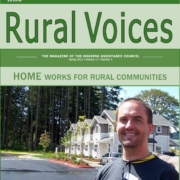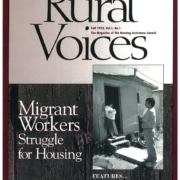HAC News Formats. pdf
May 30, 2012
Vol. 41, No. 11
• Wall Street Journal criticizes USDA foreclosure actions • VA analyzes factors linked to homelessness among veterans • Housing and ACS funding bills have not advanced • Notice addresses liquidation value appraisals for Section 502 guaranteed • Rural prepayment clarifications issued • USDA reminds field staff about documentation for Sections 514, 515, and 516 • USDA RD field staff have access to new cost data tool • Minorities and renters undercounted in 2010 Census • Vacancy rate higher in rural America, HAC reports • HAC blogs about rental housing policy • HOME program examined in new issue of Rural Voices • HAC seeks nominations for rural housing awards
May 30, 2012
Vol. 41, No. 11
WALL STREET JOURNAL CRITICIZES USDA FORECLOSURE ACTIONS. A May 25 article headlined “USDA is a Tough Collector When Mortgages Go Bad” describes USDA’s efforts to collect funds from borrowers who obtained Section 502 guaranteed mortgages, then lost income and lost their homes to foreclosure. Links to the article, online comments, and responses from HAC, the National Rural Housing Coalition, and others are posted on HAC’s site.
VA ANALYZES FACTORS LINKED TO HOMELESSNESS AMONG VETERANS. “Homeless Incidence and Risk Factors for Becoming Homeless in Veterans” reports that the presence of mental illness and/or substance-related disorders was the strongest predictor of becoming homeless after discharge. Homeless vets were also more likely to have served in Afghanistan or Iraq. In the population studied, Afghanistan/Iraq vets and women were most likely to use HUD-VASH vouchers. The VA study did not include urban-rural or other geographic information. The Daily Yonder reports that Census data show that generally vets disproportionately live in rural and exurban communities, although those who served after 1990 are not overrepresented in rural America.
HOUSING AND ACS FUNDING BILLS HAVE NOT ADVANCED. Dates have not been determined for full Senate consideration of FY13 funding bills for USDA, HUD, or the Census Bureau’s American Community Survey (see HAC News, 5/16/12). The HAC News and HAC’s website will report updates when available.
NOTICE ADDRESSES LIQUIDATION VALUE APPRAISALS FOR SECTION 502 GUARANTEED. Administrative Notice 4646 provides direction on obtaining a liquidation appraisal report to determine USDA’s loss claim for a 502 guaranteed property that has been taken into REO by the lender. Contact a USDA RD field office.
RURAL PREPAYMENT CLARIFICATIONS ISSUED. Subjects covered by USDA in an Unnumbered Letter dated May 14, 2012 include the distinction between prepayment and partial or final payments, and handling of incentives for property owners if ownership is transferred. Contact a USDA RD field office.
USDA REMINDS FIELD STAFF ABOUT DOCUMENTATION FOR SECTIONS 514, 515, AND 516. Administrative Notice 4645 addresses weaknesses identified in a 2011 management control review. Contact a USDA RD field office.
USDA RD FIELD STAFF HAVE ACCESS TO NEW COST DATA TOOL. An Unnumbered Letter dated April 20, 2012 announces the availability for staff of data reports that can be used to compare costs in multifamily housing and for other purposes. Contact a USDA RD field office.
MINORITIES AND RENTERS UNDERCOUNTED IN 2010 CENSUS. The Census Bureau has calculated that overall the 2010 Census was accurate although, as in previous decades, certain groups were undercounted. African Americans were undercounted by 2.1% and Hispanics by 1.5%. Asians and Native Hawaiians and Other Pacific Islanders had no statistically significant error rate. American Indians and Alaska Natives living on reservations were undercounted by 4.9%, while there was no statistically significant error rate for those not living on reservations. Renters were undercounted by 1.1%.
VACANCY RATE HIGHER IN RURAL AMERICA, HAC REPORTS. A new Rural Research Note, “Housing Occupancy and Vacancy in Rural America,” reports that housing vacancy rates in rural and small town areas are approximately 7 percentage points higher than the national level. Much of the higher vacancy rate in rural areas is due to the number of homes unoccupied for seasonal, recreational, or occasional use. Nearly 60% of all vacant seasonal or recreational homes nationwide are in rural and small town areas.
HAC BLOGS ABOUT RENTAL HOUSING POLICY. In the first of a series of contributions to the National Housing Institute’s Rooflines blog, HAC wonders, “What Does an Affordable Rural Rental Housing Strategy Look Like?” and suggests both general and specific components of such a strategy.
HOME PROGRAM EXAMINED IN NEW ISSUE OF RURAL VOICES. The spring issue of HAC’s quarterly magazine includes over 25 brief success stories from rural organizations that have used the HOME program to develop housing, create jobs, and provide decent affordable housing, as well as pieces from Senator Patrick Leahy (D-VT) and former HUD official Mercedes Marquez and a summary of what proposed changes in HOME regulations could mean for rural places.
|
HAC SEEKS NOMINATIONS FOR RURAL HOUSING AWARDS. Nominations are due September 28 for the Cochran/Collings Award for national rural housing service and the Skip Jason Community Service Award. The honors will be presented at the National Rural Housing Conference in December. Details will be available soon at https://ruralhome.org or from Lilla Sutton, HAC, 202-842-8600, lilla@ruralhome.org.
|


